Abstract
This article explores the application of clinical decision-making (CDM) skills training through the use of virtual simulation (VS) in community health nursing (CHN) coaching. The article aims to examine the theoretical underpinnings of the efficacy of virtual simulations (VS) in fostering learning and skill development within the context of the clinical nurse specialist (CNS) process of assessment, diagnosis, analysis, planning, mediation, and evaluation. This article also analyses the ongoing research on the application of VS in CHN education, focusing on the pros and cons of using this instructional strategy. VS offers a unique teaching method that can boost the training of nursing students to become highly proficient practitioners by offering a safe and regulated setting in which to practice CHN-related skills.
Introduction
Community health nursing (CHN) is an integral part of nursing education, as it involves caring for diverse populations in various settings. CHN education gives nursing students the understanding, abilities, and attitudes to provide adequate care to individuals, families, and communities. However, due to limited exposure to real-world situations, many nursing students need help developing clinical decision-making (CDM) skills in this area (Huber, 2020).
Nursing educators use various teaching methods to promote learning and enable students to become highly skilled practitioners in today’s healthcare environment. One of the newest methodologies is a virtual simulation (VS), which renders systematic practice offers for CHN learners to maintain and develop Society’s healthcare nurse-associated abilities (Hoffman & Argeros, 2021). The virtual simulation used in CHN education assists students in engaging in the CHN procedure of assessment, diagnosis, analysis, structuring, intervention, and estimation.
The efficiency of (VS) in nursing tutoring refers to using computer-based simulations to provide nursing students with realistic clinical scenarios that mimic real-world patient care situations. (VS) has become highly popular in nursing tutoring as it provides a safe, controlled environment for students to develop clinical abilities and knowledge without putting actual patients and students at risk (Sutherland et al., 2021). This paper explores the theoretical framework behind the effectiveness of virtual simulation on CHN education for improving clinical decision-making skills and examines the current literature on its use in improving CHN education outcomes.
Importance of Theoretical Framework and Research Question
Framing is an essential aspect of communication that involves presenting an idea in a particular way to convey a message effectively. It involves using visuals, values, stereotypes, and messengers to shape our perception of the world and interpret information (Kim et al., 2019; Kim et al., 2015). A theoretical framework is a critical component of research that provides a theoretical foundation for the study and guides the examination process. It allows researchers to organize their ideas, hypotheses, and research questions and provides a framework for interpreting the findings.
Framing is crucial in enhancing writing and making the research ideas make sense. The importance of framing can be extracted from the definition of frames, which are the underlying assumptions and beliefs that shape our view of the world and influence how we interpret information and make sense of our experiences. The significance of a theoretical framework for research originates from that point, and it is important to note how it relates to the topic at hand. Therefore, engaging researchers with certain beliefs in their research gives them the power to shape the research direction during all research processes starting from designing the study, formulating research questions, and identifying data collection and analysis methods (Caldwell et al., 2011; Dorfman et al., 2005).
In the case of studying the efficiency of effecting simulation in CHN education for enhancing clinical decision-making, a theoretical framework based on the clinical thinking process and decision-making models is necessary. This framework helps to explain the cognitive and affective processes used by healthcare professionals to make clinical decisions and provides a structure for evaluating the potency of virtual simulation in enhancing clinical decision-making skills.
The research question for this study is, “How can we use virtual simulation to enhance medical decisions in CHN training?” This well-focused and pertinent inquiry explores what can hone clinical judgment skills in the context of CHN training. By offering a framework for assessing the clinical thinking processes and ruling models, the conceptual model lays the groundwork for resolving the question.
Theoretical frameworks are essential for contextualizing and justifying the research question or hypothesis. In the case of studying the potency of virtual simulation in CHN Learning, the theoretical framework helps establish the study’s context as it is focused on an essential aspect of nursing education. The framework also provides a foundation for interpreting the study’s results and establishes a clear link between the research question and outcomes.
Existing Literature on the use of Virtual Simulation in Nursing Education
The existing literature on the use of virtual simulation in nursing coaching is growing, with many studies exploring the effect of this technology on various aspects of medical education. However, the important ones are revised as a framework of the entire article. Atthill et al. (2021) researched post-game virtual asynchronous debriefing in facilitating medical decisions based on simulation. The study found that this effective method effectively enhanced the decision-making process’s standing and improved thinking skills.
Another study by Caldwell et al. (2011) focused on developing a framework for critiquing health research. Although not specifically related to virtual simulation, the study is relevant as it highlights the importance of theoretical frameworks in research. The framework developed by the authors can be used to examine the quality and relevance of the investigation, which is particularly important when considering the use of virtual simulation in nursing education.
Chircop and Cobbett (2020) evaluated the use of Sentusing 3.0 virtual simulation in society. The study found that virtual simulation enhanced students’ understanding of community health issues and improved their ability to identify and manage health problems in a community setting. The authors finalized that (VS) can be a valuable tool in preparing nursing students for community health nursing.
Finally, Denzin and Lincoln’s (2011) Handbook of Qualitative Research is a comprehensive resource for researchers interested in qualitative research methods. Although not explicitly focused on virtual simulation, the book lays a theoretical groundwork for qualitative research. It provides direction on various components of the study process, such as collecting and interpreting data.
In general, the research that has been done on the application of simulation environments in nursing curricula reveals that this technology has the potential to be a valuable instrument for improving students’ comprehension of medical decisions, community health issues, and other aspects of nursing practice. However, more analysis is required to fully understand the effect of virtual simulation on nursing education outcomes and to identify best practices for incorporating this technology into nursing curricula.
Literature Review Search Design
The protocol for this review was drafted using Preferred Reporting Items for Systematic Reviews and Meta-Analyses (PRISMA), outlined by Tricco et al. (2018). This protocol was selected because it has been approved as emerging evidence and helps to design a robust understanding of study concepts and terminology appointed to conduct the literature review study (Tricco et al., 2018). The investigator conducted the first step using two limited electronic databases, CINAHL (EBSCO) and Medline (Ovid). The second step was conducted with the assistance of an experienced librarian (Ilo-Katryn Maimets MSc (Biol), BEd, MISt). Three electronic bibliographical databases were used, ERIC, CINAHL (EBSCO), and Medline (Ovid), selected to help achieve the study objective. Extracting and organizing the data used Zotero (6.0.15) as a reference management software for summarizing and charting the data in the PRISMA flow chart. The keywords used for this literature review for searching the three databases used the PICO search strategy as in Table 1:
Table 1: Search Strategy Flowchart
| PICO Element | Keywords |
| Population | Community Health Nursing students |
| Intervention /Concept | Virtual Simulation |
| Context / Control | Education, Traditional class |
| Outcome | Clinical Decision Making |
Analysis of the Literature
Appendix Summary of Articles presents thirteen studies remaining eligible for this literature review. The research methodology used in these thirteen studies is the following: Four studies used a mixed method, three studies were qualitative, four studies were quantitative methods, two were quasi-experimental designs, and two were randomized controlled trials. Table 2 shows the analysis of these thirteen studies; nine were performed in the USA, two in Canada, one in the UK and another in Ireland. Data synthesis explains how the research results relate to the research question and summarizes all included literature based on research questions in diagrammatic or tabular format. This data synthesis can help improve the understanding of inconsistencies in various literature and identify research gaps in evidence to represent future research (Polit & Beck, 2020). Four studies concentrated on the impact of virtual simulation on clinical decision-making among nursing students (Kool, 2021; Anthill et al., 2021; McCallum et al., 2011; Saab et al., 2022). Five studies focused on applying VS as an alternative to clinical sites among clinical health nursing students (Hoffman & Argeros, 2021; Keiser et al., 2022; Schaffer et al., 2016; Chircop et al., 2020; Hoffman & Argeros, 2021). Four studies investigated virtual simulation’s impact in different public health areas (Tilton et al., 2015; Menzel et al., 2014; Smith et al., 2016; Leibold et al., 2017). No study examined the effectiveness of virtual simulation on CDM among CHN students.
The results of the thirteen studies can be synthesized as the following subheadings illustrated: The advantages and disadvantages of virtual simulation in nursing education (Hoffman & Argeros, 2021). The importance of orientation is based on how it can help improve the learning experience of virtual simulation (Schaffer et al., 2016). The importance of debriefing after virtual simulation (Atthill et al., 2021; Hoffman & Argeros, 2021; Tilton et al., 2015) and identified a significant shortage of studies about methods used in virtual simulation educational strategies and measurements of the outcome in nursing education (McCallum et al., 2011). As well as there is an urgent need to research how theories or frameworks inform the implementation of virtual simulation into CHN programs which can improve among nursing disciplines (Leibold et al., 2017; Schaffer et al., 2016).
Regarding the application of theoretical frameworks, among the studied articles, three studies utilized the Experiential Learning Theory (Atthill et al., 2021; Kool, 2021; Chircop et al., 2020), while three others used the Adult Learning Theory (Hoffman & Argeros, 2021; Menzel et al., 2014; Smith et al., 2016). One study (Hoffman & Argeros, 2021) employed the Cognitive Theory of Multimedia Learning, and another (McCallum et al., 2011) utilized the intuitive humanistic approach. Furthermore, one more study (Leibold et al., 2017) applied The Identification/Situation/Background/Assessment/Recommendation (ISBAR) framework. However, the remaining studies did not utilize any particular theoretical framework in their research.
The philosophical assumptions underlying thirteen studies were analyzed, and the results showed that the studies could be classified into four different paradigms. Four studies were conducted using the pragmatism paradigm (Keiser et al., 2022; Hoffman & Argeros, 2021; Hoffman & Argeros, 2021; Tilton et al., 2015), while another four studies were conducted using the positivism paradigm (McCallum et al., 2011; Kool, 2021; Menzel et al., 2014; Smith et al., 2016). Three studies were based on the constructivist interpretivism paradigm (Atthill et al., 2021; Leibold et al., 2017; Saab et al., 2022), and only two used the constructivism paradigm (Chircop et al., 2020; Schaffer et al., 2016).
Table 2: Search Strategy Flowchart
| Study Location | Research Design | Philosophical Paradigm. | Theoretical Framework | |||||
| Canada | 2 | Mixed methods | 4 | Positivism | 4 | Experiential Learning Theory
(Kolb 1984)
|
3 | |
| USA | 9 | Quantitative | 4 | Constructivist Interpretivism | 3 | Adult Learning Theory
(Knowles, 1984) |
3 | |
| UK | 1 | Qualitative | 3 | Constructivism | 2 | Cognitive Theory of Multimedia Learning
(Mayer, 1999) |
1 | |
| Ireland | 1 | Pragmatism | 4 | The intuitive humanistic approach | 1 | |||
| The Identification/ Situation/ Background/ Assessment/ Recommendation (ISBAR) | 1 | |||||||
| Not mentioned | 4 | |||||||
Synthesis of the Strengths and Weaknesses of the Literature
The four sources reviewed demonstrate the potential benefits of virtual simulation technology in nursing education, particularly in enhancing students’ clinical decision-making skills, critical thinking abilities, and understanding of community health issues. According to the findings of a study conducted by (Atthill et al., 2021), participating in a digital simulation followed by an asynchronous virtual debriefing session is an efficient way for learners to enhance their critical thinking abilities and their comprehension of the judgment process. Chircop and Cobbett’s (2020) study also showed that virtual simulation helped prepare for community health nursing.
However, the sources also have limitations. Atthill et al.’s (2021) study only used one virtual simulation game and did not evaluate the effectiveness of the debriefing method on other types of games or simulations. Caldwell et al.’s (2011) framework for critiquing health research is practical, but it is not specific to virtual simulation research. Moreover, the framework has yet to be widely adopted and may not be well-known outside nursing education research.
Chircop and Cobbett’s (2020) study had a small sample size, which restricted the generalizability of their results. Nevertheless, while virtual simulation can provide an alternative to traditional clinical placement in community settings, it cannot fully replicate the complexity and nuances of real-world interactions with patients and community members. Denzin and Lincoln’s (2011) Handbook of Qualitative Research provides a comprehensive guide to conducting qualitative research but does not explicitly address virtual simulation research.
Overall, the literature on virtual simulation in nursing tutoring has shown promising results in enhancing students’ clinical decision-making capabilities. However, further research is needed to evaluate the effectiveness of different virtual simulation methods and address the existing studies’ limitations. It is also essential to consider the potential limitations of (VS) technology and to use it as use it to complementinical experience.
Knowledge Gaps
After thoroughly reviewing the literature, several knowledge gaps will be addressed. Three themes were identified based on these gaps. The first was the need for a theoretical framework that links the concepts of virtual simulation, clinical decision-making, and community health nursing (Smith et al., 2016). This is in line with the recommendations of previous studies, which emphasized the urgent need for research on how theories or frameworks can inform the implementation of virtual simulation into community health nursing programs to improve nursing disciplines.
The second theme of the study focuses on the philosophical paradigm, specifically post-Positivism, which has been chosen due to the absence of literature utilizing this paradigm and its fundamental assumptions aligning with quantitative research (Shin et al., 2015). Post-Positivism accepts the positivist principles but recognizes limitations, such as the impossibility of acquiring absolute knowledge of reality (O’Flaherty & Costabile, 2020). It is based on the understanding that knowledge is not purely objective, and the researcher’s role is to minimize subjectivity as much as possible. Post-Positivism emphasizes the importance of testing hypotheses through observation and empirical evidence while acknowledging the impact of values, beliefs, and biases on research. Thus, this paradigm aligns with the research aim of investigating the impact of (VS) on medical learners’ clinical decision-making while considering potential subjective influences on the research results.
The third theme highlights that Virtual simulation has been popularly researched in nursing tutoring, including its potential to improve clinical decision-making skills. However, there needs to be more research on how virtual simulation can specifically benefit future nurses in community health. The use of computer-generated environments for learning in nursing is growing in popularity. However, it is still being determined if this method is more effective than traditional instruction in developing competent decision-making skills (Hudson et al., 2019). As the clinical choice is an essential feature of nursing, it is crucial to identify the most effective teaching methods for students, particularly those in community health. Enhancing the CDM skills of CHN students is crucial to their ability to provide high-quality care to their communities.
In conclusion, the purpose of my research is to solve these problems by establishing a theoretical framework, making use of a post-positivism paradigm, and concentrating on the impact that virtual simulation has on nursing instruction and clinical judgment, in particular among nursing learners who are pursuing a degree in society medical nursing (Kool, 2022). This will make an essential contribution to the existing literature and give educators and policymakers valuable insights that can be used to improve nursing students and the results for patients.
Post-Positivism Paradigm
Post-positivism paradigm is derived from the positivism tenets since it emphasizes that human knowledge is based not based on foundational and unchanged beliefs. This paradigm is concerned with the sound judgment of reality and deviates from the researcher’s objective stance, which was previously adopted by logical positivism, which claimed that a single tangible reality exists and can be measured, understood and identified (Panhwar et al., 2017). Hence, the post-positivism paradigm allows for critical realism, which elaborates that reality is independent of human thinking and can be studied by science (Panhwar et al., 2017).
Post-positivism paradigm has been determined to sit on a spectrum between interpretivism and positivism; this implies that some of its ideas are more closely to positivism, and others take a more balanced approach that depends on the research focus. It has been determined that this paradigm rejected the assumption that the researcher can be considered an independent observer of the social world. However, it argued that their identity and ideas influence their observations and thus impact their conclusion about any study. Thus, positivists affirm that to pursue objective answers, one ought to recognize and adopt such biases in the study aligned with the theories developed by various theorists (McGlinchey, 2021). This approach emphasizes understanding the individual and their interpretation of the world. This shows that reality, according to this paradigm, is socially constructed and varies in different social contexts.
There exist ontological, epistemological and methodological belief differences between the competing paradigms, which have been considered alternative inquiry methods. Based on ontology, post-positivism insists on critical realism, which posits that reality is imperfect. However, positivism believes in objective reality but apprehendable, critical theory emphasizes historical reality, which implies that it is shaped by various factors over time, while constructivism insists on realism, which implies that reality is specific and locally constructed (Guba & Lincoln, 1994). Based on epistemology, post-positivism insists on modified objectivists or dualists, where community and tradition influence reality. At the same time, other paradigms like positivism rely on dualists or objectivists, which posits that findings are factual. The critical theory believes in a subjectivist model. At the same time, the constructivism approach implies that the findings are accurate.
Conceptual Framework
Based on the information provided, the aim of choosing a conceptual framework is to address a knowledge gap in the literature about how theories or frameworks can inform the implementation of virtual simulation into CHN programs, to improve nursing practices across different disciplines.
A conceptual framework is essential in conducting research as it helps guide the study and organize the research findings. Using a conceptual framework, researchers can better understand the theoretical foundations of their study, identify critical variables and relationships, and develop hypotheses to test. In this case, the conceptual framework will likely provide a structure for understanding the different components and processes involved in implementing virtual simulation in CHN programs and the potential impact on nursing practices.
Leibold et al. (2017) and Schaffer et al. (2016) have identified the need for a conceptual framework in this area of research. Using a conceptual framework, researchers can address the knowledge gap identified in these studies and contribute to developing best practices for virtual simulation in CHN programs. The essential variables and concepts used for the paper are conceptually and operationally defined as follows:
Clinical decision-making: is defined as a multi-step process that involves collecting relevant data and inferences about a patient, interpreting this information in the context of current evidence and knowledge, and critically evaluating this information to arrive at possible solutions and select the best course of action for the patient (Campbell et al., 2007). Virtual simulation, on the other hand, refers to computer-generated environments that simulate real-world clinical scenarios and gives nursing learners a chance to operate and refine their clinical choice in a safe and controlled environment. By defining these key concepts, the study can ensure consistency in the interpretation and application of these concepts and facilitate comparisons across different learning in the sector of virtual simulation in CHN education.
Community Health NursesStudents: are aspiring healthcare professionals enrolled in nursing programs emphasizing the development of competencies needed to provide comprehensive, patient-centred nursing care in diverse community settings (Dorfman et al., 2005). They are equipped with the information and abilities essential to manage complicated health disorders at the community level, promote health, prevent disease, and manage health conditions. Community Health Nursing students possess a deep understanding of the social factors of health and the ability to collaborate with multidisciplinary teams to address health disparities and improve health outcomes in their communities (Tilton et al., 2015). Their education prepares them to provide evidence-based, culturally competent care to individuals, families, and communities across the lifespan while advocating for health equity and social justice.
Virtual simulation: is an educational game that does not include any elements of fun or amusement. Within a creative methodology, it implements computer-based learning situations for educational purposes (Leibold & Schwarz, 2017). Students have the opportunity to take part in the scenario for a variety of different reasons, some of which include the following. However, they are not limited to the promotion of the growth of cognitive and spatial, reminiscence, strategic, sensorimotor, and visual attention abilities, as well as the acquisition of new information or a new skill.
Shepard et al. (2010) reported that simulation provides an appropriate learning experience and realistic learning environment and better prepares nursing students for patient care demands. CHN Students are aspiring healthcare professionals prepared to provide nursing care in community settings. They might employ Virtual Simulation, a digital method that puts students in realistic situations meant to mimic clinical expertise, as part of their education. Using Virtual simulation, students can develop CDM skills, which refer to the cognitive procedure involved in making clinical judgments and selecting appropriate interventions to address patient needs (Huber, 2020). Finally, using virtual simulation and developing their CDM skills, CHN Students can enhance their Student Knowledge, which refers to the understanding base and competencies needed to provide safe and effective nursing care.
In this conceptual framework (Figure 1), virtual simulation bridges CHN Students and CDM, providing a realistic environment for learners to refine their clinical reasoning skills. Clinical Decision Making, in turn, contributes to the development of Student Knowledge. It enables learners to apply theoretical understanding to current-life occurrences and make informed decisions based on evidence-based practice (Hogan et al., 2011; Keiser et al., 2022). Virtual simulation can help provide feedback based on CHN education to modify or improve the quality of provided knowledge to nursing students. Furthermore, virtual simulation can directly affect nursing students’ knowledge, which can help them improve their clinical decision-making. It may influence CHN education based on the conceptual framework model.
Figure 1: Effect of Virtual Simulation in Community Health Nursing Education.
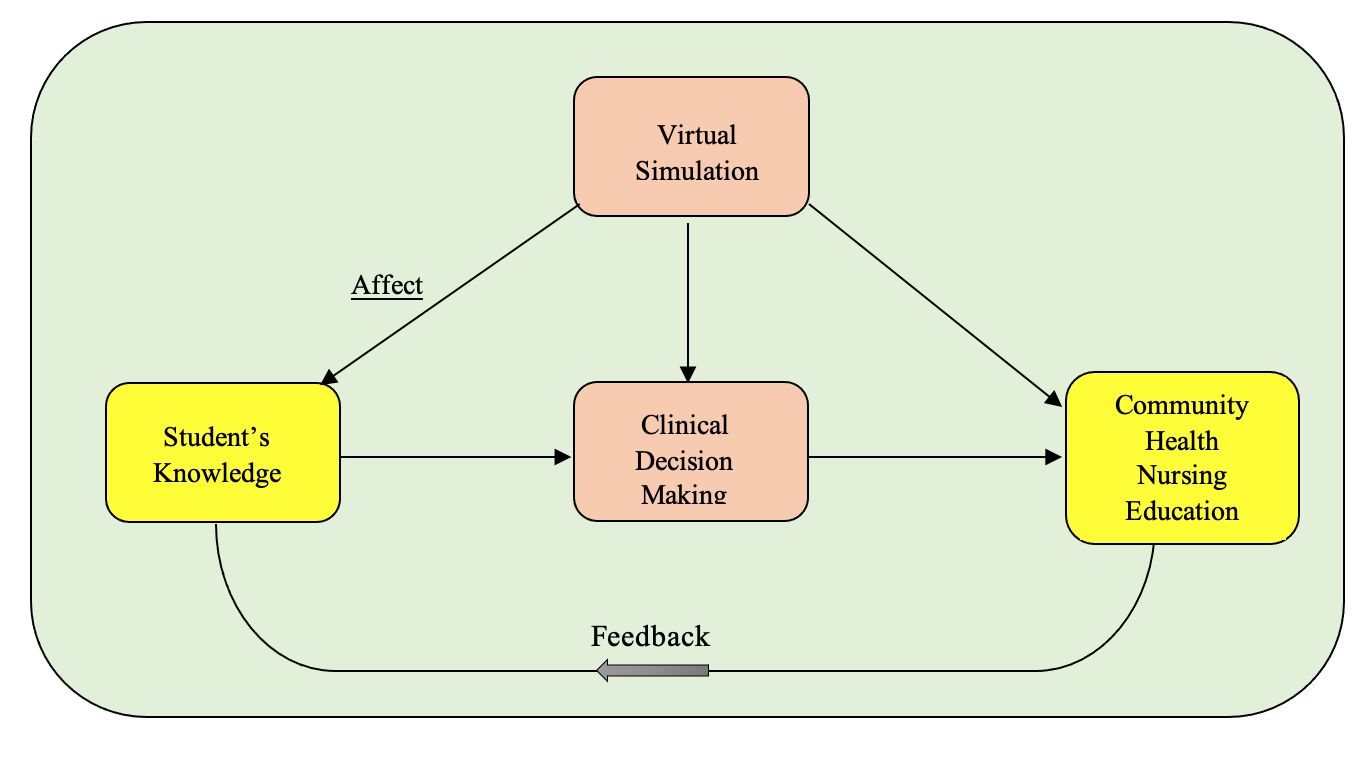
Research Questions
The study question has been framed about the previous research and evidence-based practice recommendations. Is there a significant difference in the ability to do CDM between students of community health nursing who have received a formal education and those who have taken virtual simulation classes?
The conceptual framework, post-positivism paradigm, and research question are interrelated and guide the research study. The conceptual framework provides a theoretical foundation for the study, linking the concepts of virtual simulation, clinical decision-making, and community health nursing. Sutherland et al. (2021) stipulate that it helps guide the development of research questions and provides a structure for data analysis. In this case, the conceptual framework will guide the study in examining the effect of (VS) on CDM ability for community health nursing learners compared to traditional education.
A post-positivist paradigm is a philosophical stance adopted for the study. It is a quantitative research paradigm that assumes that reality is objective and can be measured and observed through empirical data. A post-positivist paradigm is a scientific approach that aims to discover causal relationships between variables (Saab et al., 2022). In this case, the paradigm will guide the study using empirical data to compare the CDM ability of community health nursing students with traditional education with virtual simulation classes.
The research question is based on the concepts and relationships identified in the theoretical framework. It focuses on comparing the CDM ability of community health nursing students who have traditional education with those who have virtual simulation classes. The research question will guide the study in collecting and analyzing data to determine whether CDM ability significantly differs among the two classes.
Overall, the conceptual framework, post-positivism paradigm, and research question are essential components of the research study. They work together to provide a theoretical foundation, a philosophical stance, and a focus for the study. Together, they will guide the study in examining the effect of virtual simulation on CDM ability for community health nursing learners.
Conclusion
Utilizing (VS) in nursing tutoring is gaining popularity since it offers a secure and managed-to-set within which learners can enhance their clinical skills without risking the lives of actual patients or other students. This study examines the effect of virtual simulation on CHN education in increasing CDM skills and analyzes the existing literature on its usage in improving CHN education outcomes. Specifically, the paper focuses on using (VS) to improve CHN education outcomes.
Thirteen research publications assessing the functionality of virtual reality and simulation systems in nursing modules were chosen for this systematic review. Their strengths and shortcomings were discussed in light of the literature. Although the studies emphasize the critical advantages of employing VR/Sim in nursing education, their inadequate sample volumes and other constraints restrict the transferability of the findings. More study is required to fully understand how these changes may affect future nursing curricula and patient outcomes.
The review identified three themes that require further research. The first theme is the need for a theoretical framework that links the concepts of virtual simulation, CDM, and CHN. The second theme is the philosophical paradigm used in the research, post-positivism. No literature utilized this paradigm, and the basic assumptions of this paradigm match the researcher’s assumptions as a quantitative researcher. The third theme is the research question, which focuses on the effect of (VS) on nursing education and CDM, specifically among CHN students.
The study aims to construct a theoretical framework, use a post-positivism paradigm, and emphasise virtual simulation’s impact on nursing education and CDM, particularly among CHN students. This will benefit the existing literature and give educators and policymakers vital insights that can be used to improve nursing education and patient results.
References
Atthill, S., Witmer, D., Luctkar-Flude, M., & Tyerman, J. (2021). Exploring the impact of a virtual asynchronous debriefing method after a virtual simulation game to support clinical decision-making. Clinical Simulation in Nursing, 50, 10-18. https://doi-org.ezproxy.library.yorku.ca/10.1016/j.ecns.2020.06.008
Caldwell, K., Henshaw, L., & Taylor, G. (2011). Developing a framework for critiquing health research: An early evaluation. Nurse Education Today, pp. 31, 1–7.
Chircop, A., & Cobbett, S. (2020). Gett’n on the bus: evaluation of Sentinel City® 3.0 virtual simulation in community/population health clinical placement. International Journal of Nursing Education Scholarship, 17(1). https://doi.org/10.1515/ijnes-2019-0109
Denzin, N. K., & Lincoln, Y. S. (Eds.). (2011). The Sage handbook of qualitative research. Sage.
Dorfman, L., Wallack, L., & Woodruff, K. (2005). More than a message: Framing public health advocacy to change corporate practices. Health Education & Behaviour, 32(3), 320-336.
Foronda, L., Fernandez-Burgos, M., Nadeau, C., Kelley, N., & Henry, N. (2020). Virtual simulation in nursing education: a systematic review spanning 1996 to 2018. Simulation in Healthcare, 15(1), 46-54. https://doi.org/10.1097/SIH.0000000000000411
Guba, E. G. & Lincoln, Y. S. (1994). Competing paradigms in qualitative research. In N. K. Denzin & Y. S. Lincoln (Eds.), Handbook of qualitative research (pp. 105–117). Sage.
Hoffman, J. L., & Argeros, G. (2021). Effects of a Virtual Educational Intervention to Teach Interprofessional Collaboration to Community Health Nursing Students. Journal of Community Health Nursing, 38(4), 209-220. https://doi.org/10.1080/07370016.2021.1972245
Hoffman, J. L., & Argeros, G. (2021). Using virtual simulation to teach community health nursing students about public health nursing. Journal of Community Health Nursing, 38(4), 244–252. https://doi.org/10.1080/07370016.2021.1972248
Huber, S. W. (2020). Knowledge of content for clinical nursing educators: An ethnographic investigation of clinical experts who transition to the role of novice clinical nursing educator (Publication No.7626). [Doctoral dissertation, West Virginia University]. Research Repository.
Hudson, H., Perron, A. & Wright, D. (2019). Palliative care and the injustice of mass incarceration: Critical reflections on a harm reduction response to the end of life behind bars. Witness: The Canadian Journal of Critical Nursing Discourse, 1(2), 4–16.
Keiser, M., Turkelson, C., Smith, L. & Yorke, A. (2022). Using interprofessional simulation with telehealth to enhance teamwork and communication in-home care. Home Healthcare Now, 40 (3), 139–145. https://dx.doi.org/10.1097/NHH.0000000000001061
Kim, H. K., Ryu, S., & Jang, K. S. (2019). Effect of structured pre-simulation preparation and briefing on students’ self-confidence, clinical judgment, and clinical decision-making in simulation. Contemporary Nurse, 55(4-5), 317-329. https://doi.org/10.1080/10376178.2019.1641420
Kool, A. (2022). Virtual Simulation: Impact on Clinical Judgment. Colorado Nurse. 122 (3), 15–15. https://dx.doi.org/10.2139/ssrn.3862068
Leibold, N., & Schwarz, L. (2017). Virtual simulations: A creative, evidence-based approach to develop and educate nurses. Creative Nursing, 23(1), 29–34. https://doi.org/10.1891/1078-4535.23.1.29
McCallum, J., Ness, V., & Price, T. (2011). Exploring nursing students’ decision-making skills in a Second Life clinical simulation laboratory. Nurse Education Today, 31(7), 699–704. https://doi-org.ezproxy.library.yorku.ca/10.1016/j.nedt.2010.03.010
McGlinchey, S. (2022). Foundations of International Relations. London: Bloomsbury. https://uwe-repository.worktribe.com/output/9016393
Meleis, A. (2012). Theoretical Nursing Development & Progress. 5th Edition, Lippincott William & Wilkins, Wolters Kluwer, Philadelphia.
Menzel, N., Willson, L. H., & Doolen, J. (2014). Effectiveness of a poverty simulation in Second Life®: Changing nursing student attitudes toward poor people. International Journal of Nursing Education Scholarship, 11(1), 39-45. https://doi.org/10.1515/ijnes-2013-0076
O’Flaherty, J., & Costabile, M. (2020). Using a science simulation-based learning tool to develop students’ active learning, self-confidence and critical thinking in academic writing. Nurse Education in Practice, p. 47, 102839. https://doi.org/10.1016/j.nepr.2020.102839
Panhwar, A. H., Ansari, S., & Shah, A. A. (2017). Post-positivism: An effective paradigm for social and educational research. International Research Journal of Arts & Humanities (IRJAH), 45(45). https://doi.org/10.1002/nop2.306
Saab, M. M., Landers, M., Murphy, D., O’Mahony, B., Cooke, E., O’Driscoll, M., & Hegarty, J. (2022). Nursing students’ views of virtual reality in healthcare: A qualitative study. Journal of Clinical Nursing, 31(9-10), 1228–1242. https://doi.org/10.1111/jocn.15978
Schaffer, M. A., Tiffany, J. M., Kantack, K., & Anderson, L. J. (2016). Second Life® virtual learning in public health nursing. Journal of Nursing Education, 55(9), 536-540. https://doi.org/10.3928/01484834-20160816-09
Shin, S., Park, J. H., & Kim, J. H. (2015). Effectiveness of patient simulation in nursing education: a meta-analysis. Nurse education today, 35(1), 176-182. https://doi.org/10.1016/j.nedt.2014.09.009
Smith, S. J., Farra, S., Ulrich, D. L., Hodgson, E., Nicely, S., & Matcham, W. (2016). Learning and retention using virtual reality in a decontamination simulation. Nursing education perspectives, 37(4), 210–214. https://doi.org/10.1097/01.NEP.0000000000000035
Sutherland, J. L., Palmer, D., Reuther, P., & Leiby, P. (2021). Integrating home care: An innovative approach for simulation learning. Journal of Nursing Education, 60(3), 172–176. https://doi.org/10.3928/01484834-20210222-10
Tilton, K. J., Tiffany, J., & Hoglund, B. A. (2015). Non-acute-care virtual simulation: Preparing students to provide chronic illness care. Nursing Education Perspectives, 36(6), 394–395. https://doi.org/10.5480/14-1532
Tricco, A. C., Lillie, E., Zarin, W., O’Brien, K. K., Colquhoun, H., Levac, D., … & Straus, S. E. (2018). PRISMA extension for scoping reviews (PRISMA-ScR): checklist and explanation. Annals of internal medicine, 169(7), 467–473. https://doi.org/10.7326/M18-0850
Appendix
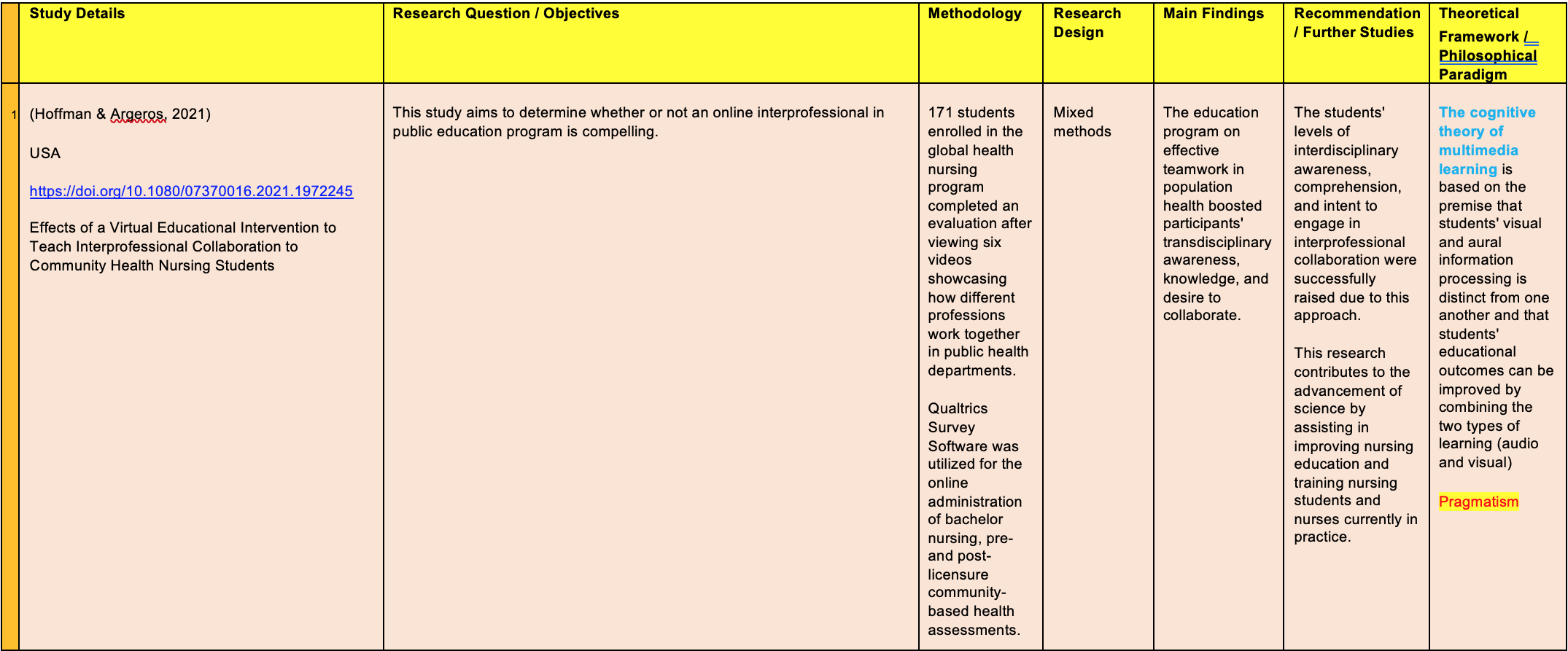

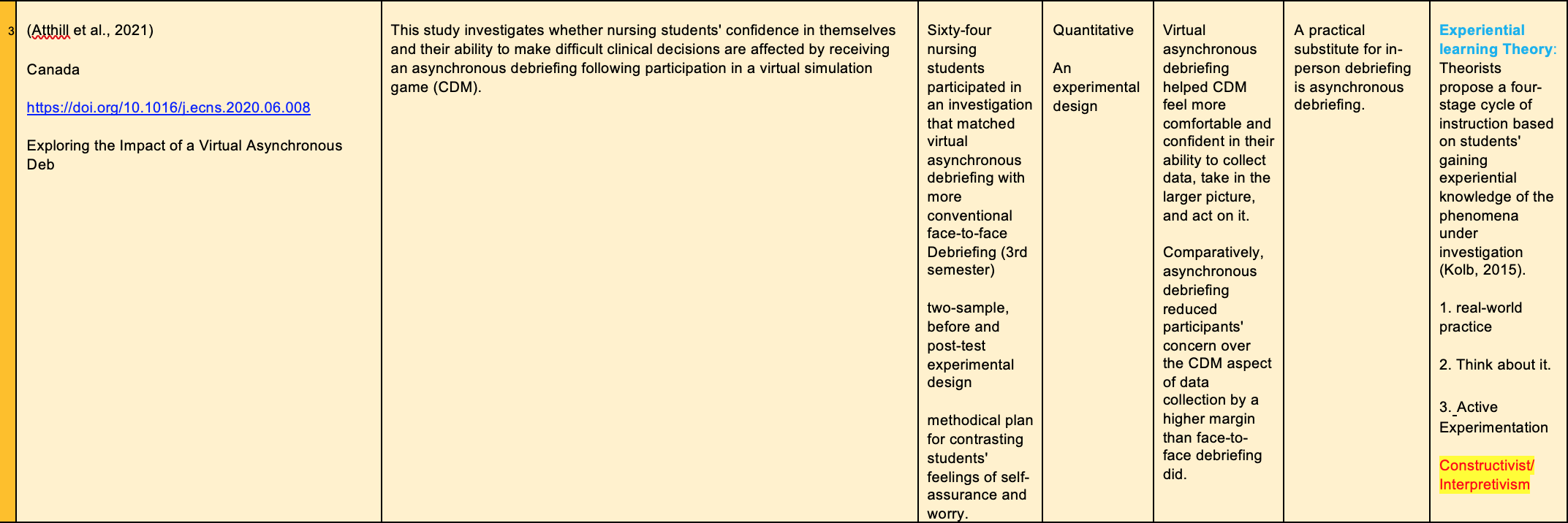
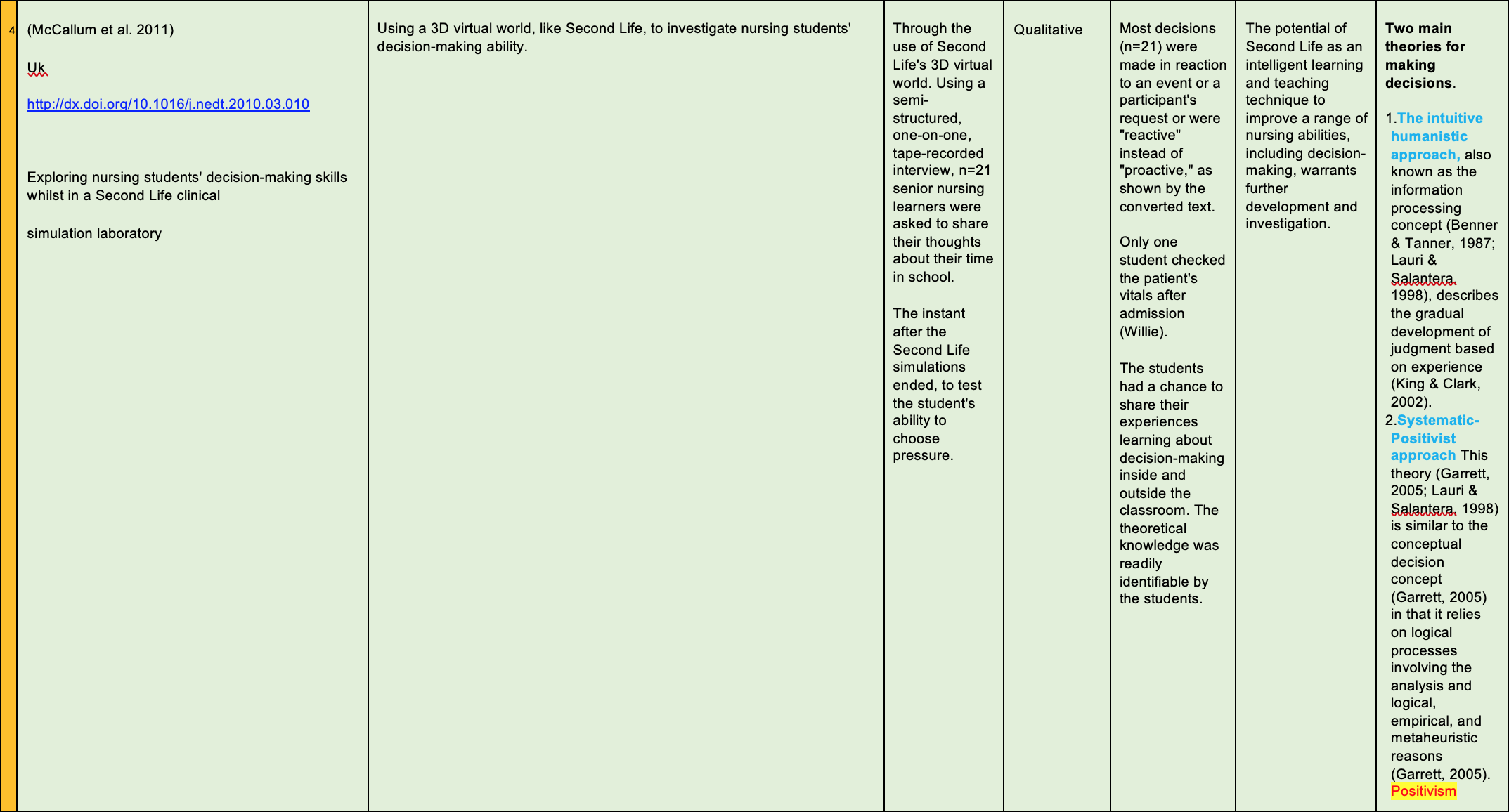

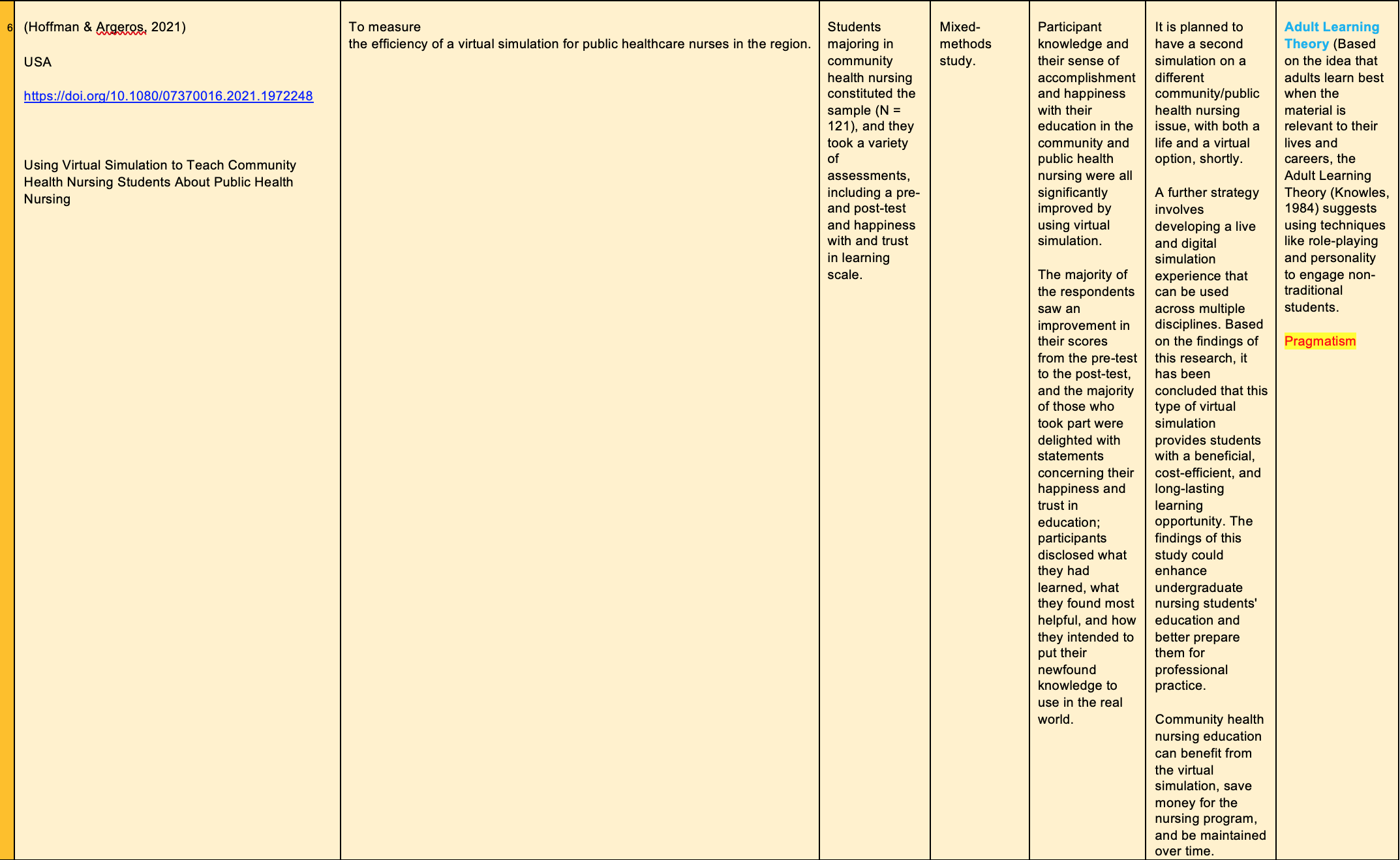
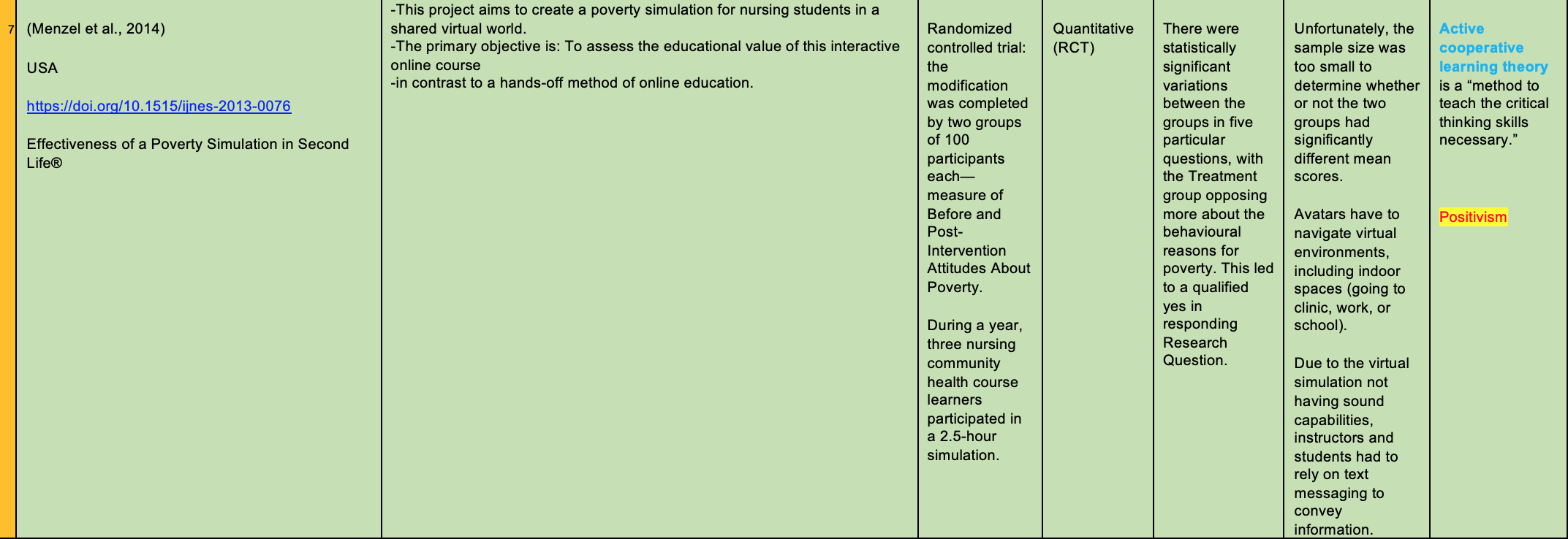


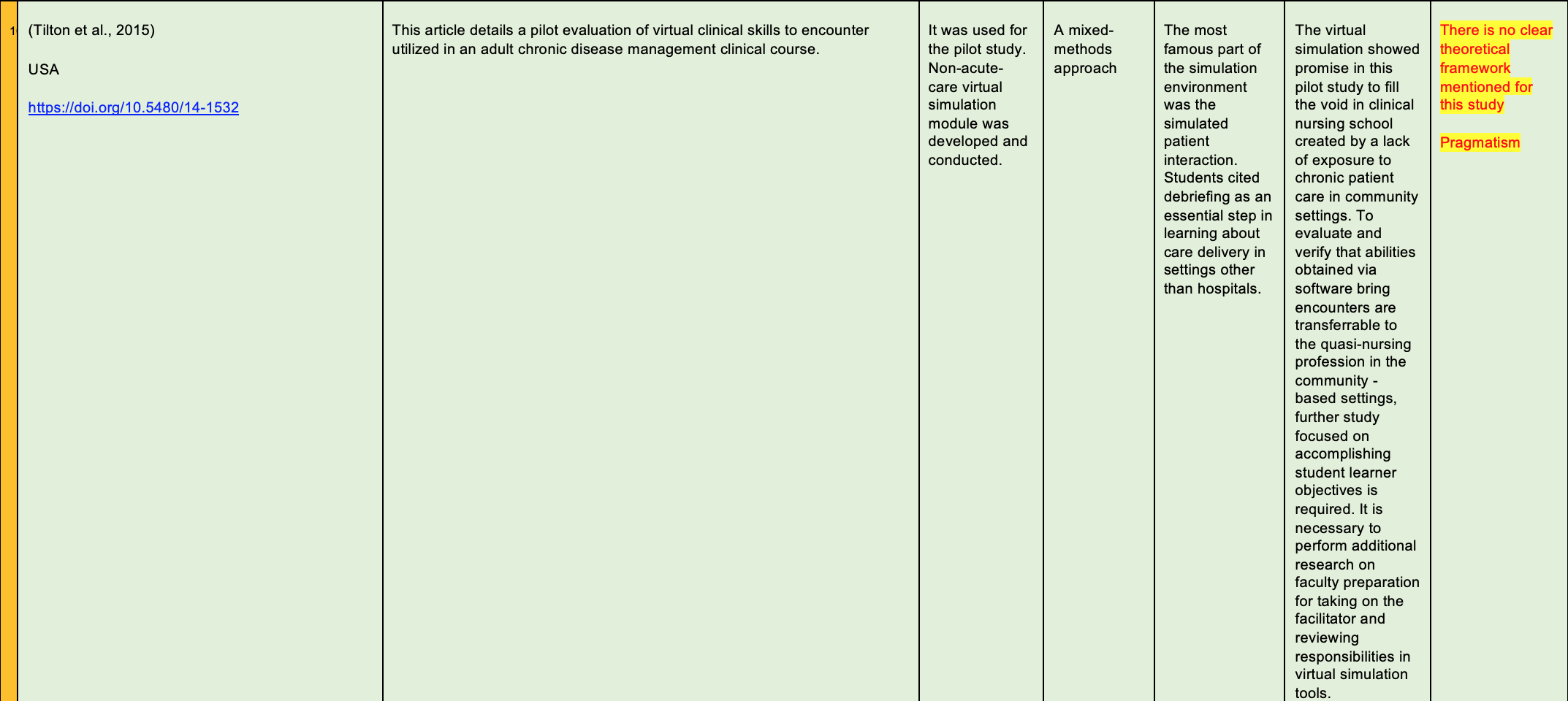
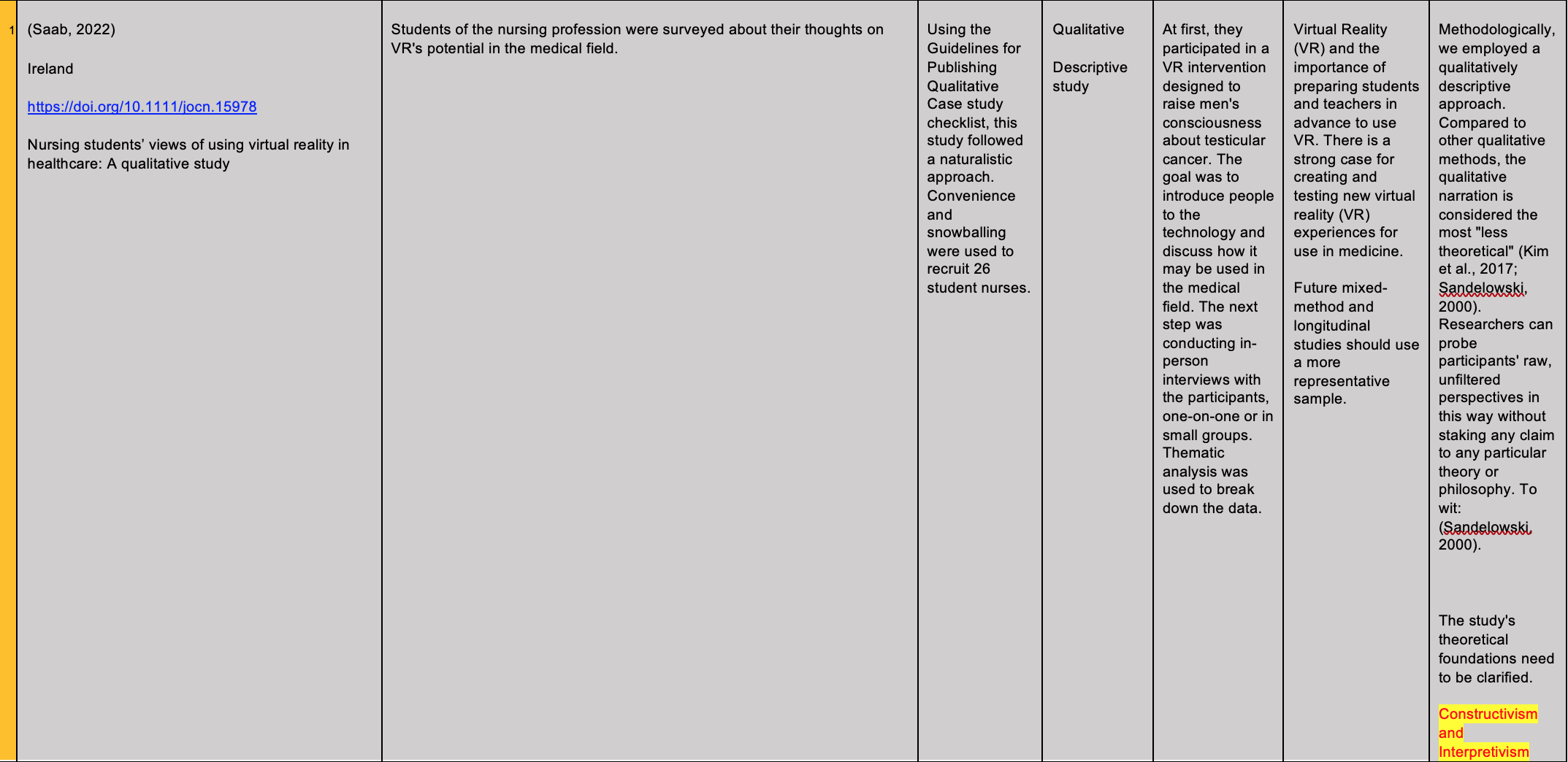


 write
write